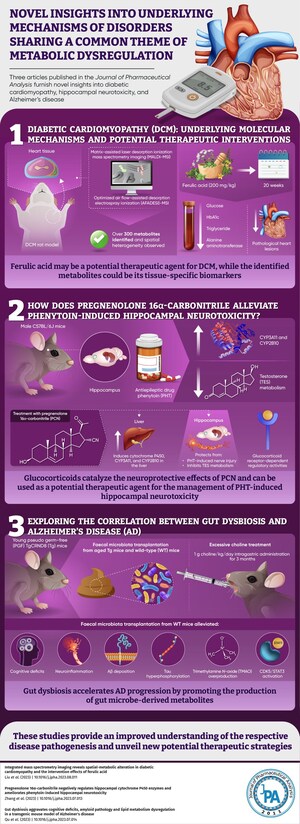New Studies in Journal of Pharmaceutical Analysis Demonstrate Advancements in Nanotechnology and Their Impact Across Multiple Areas of Human Health
Recent progress in nanotechnology paves the way for improved drug delivery, clinical diagnosis, and even environmental protection against toxic pollutants
XI'AN, China, April 8, 2022 /PRNewswire/ -- Nanotechnology research has found applications in many fields, from medicine and drug research to aeronautics and automobiles. As a global leader in nanotechnology research, China has made valuable contributions to this field. These contributions have been further emphasized by a series of recent studies from Chinese researchers, which were published in the Journal of Pharmaceutical Analysis.
The first study, made available online on May 1, 2021 and published in Volume 12 Issue 1 February 2022of the journal, was published by researchers from Anhui University of Chinese Medicine. These researchers set out to solve the problems caused by environmental contamination with chromium—a carcinogen. They developed nanodots made of carbon using natural polysaccharides from Poria mushrooms, which have no pharmacological activity. These nanodots functioned as an "on-off" fluorescent probe with the ability to detect environmental chromium. Speaking about the applications, the researchers say, "With their inexpensive source material, these nanodots allow for cost-effective and quick chromium detection, and their efficacy has been proven using actual water samples. They also represent a new avenue for the non-pharmacological application of traditional Chinese medicines and could help prevent serious health problems."
In another study, made available online on March 31, 2021 and published in Volume 12 Issue 1 February 2022 of the journal, researchers from Chongqing Medical University and Chongqing Normal University found a way to regulate the peroxidase activity of molybdenum-based quantum dots that acted as "nanozymes" (small artificial enzymes). These nanozymes caused a color change in the presence of a particular drug, and the intensity of the color change reflected the concentration of the drug. The researchers state, "These nanosensors could be used to detect drug concentrations depending on the intensity of the color change. Therefore, they could be used to develop robust pharmaceutical detection platforms to make drug assays and diagnosis easier, improving the standard of healthcare."
In the final study, made available online on March 9, 2021 and published in Volume 12 Issue 1 February 2022 of the journal, researchers from Lanzhou University used nanotechnology to develop better drug formulations. Controlled drug release helps in targeting tumors and cancer more effectively, but there are few approaches that allow controlled drug release in a tumor's intracellular microenvironment. Therefore, researchers developed a mixed drug self-delivery system (DSDS) with a high drug content that contained two forms of the chemotherapy drug doxorubicin. This system provided sustained pH-triggered drug release, which could be adjusted by manipulating the ratio of the two forms of the drug. Interestingly, laboratory tests showed that the slow-release mixed DSDS nanoparticles were highly effective in killing cancer cells. "Therefore, this platform could serve as a suitable treatment system, providing improved patient outcomes in the future," the researchers conclude.
In summary, nanotechnology acts at the intersection of various research fields and can and can revolutionize how we prevent, diagnose, and treat health conditions.
Reference
Title of original paper: Reversible regulation of enzyme-like activity of molybdenum disulfide quantum dots for colorimetric pharmaceutical analysis
Journal: Journal of Pharmaceutical Analysis
DOI: https://doi.org/10.1016/j.jpha.2021.03.010
Your Press Release Source
Journal of Pharmaceutical Analysis
Media Contact:
Fen Qiu
Xi'an, China
[email protected]
+86-131-5206-8068
SOURCE Journal of Pharmaceutical Analysis

WANT YOUR COMPANY'S NEWS FEATURED ON PRNEWSWIRE.COM?
Newsrooms &
Influencers
Digital Media
Outlets
Journalists
Opted In






Share this article